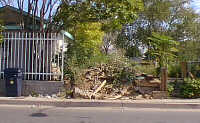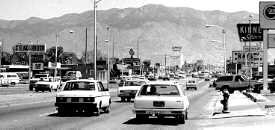 Visual
pollution generally refers to those elements of the landscape or "townscape"
that the community finds unattractive, including buildings, business signs,
stoplights and street signs, telephone and utility poles, and weeds and litter.
Stoplights, street lights, and street signs are usually included with architectural
control efforts. However, historic areas like Old Town and Huning Highlands
have stoplights and street lights that complement their historic character.
These can be seen along Central Avenue at Broadway and Edith or around the Plaza
in Old Town. Utility poles have been removed in Downtown, and in newer areas
of the city utility lines have been laid underground. This, however, is an expensive
process that the city has not yet undertaken on a large scale.
Visual
pollution generally refers to those elements of the landscape or "townscape"
that the community finds unattractive, including buildings, business signs,
stoplights and street signs, telephone and utility poles, and weeds and litter.
Stoplights, street lights, and street signs are usually included with architectural
control efforts. However, historic areas like Old Town and Huning Highlands
have stoplights and street lights that complement their historic character.
These can be seen along Central Avenue at Broadway and Edith or around the Plaza
in Old Town. Utility poles have been removed in Downtown, and in newer areas
of the city utility lines have been laid underground. This, however, is an expensive
process that the city has not yet undertaken on a large scale.
Albuquerque was first incorporated as a city in 1885, and from that time until 1976, there were no controls on signs. A merchant could raise as large a sign as he or she wished. It could blink, flash, or move as many did along Central Avenue. It could also be of any shape, like the one in the shape of a bowling pin on Menaul or the giant arrow on Indian School. The ordinance now limits the size of signs by a formula that takes into account the size of the lot, the amount of frontage on the street, and the size of the building. The size of permissible signs varies from one square foot in a residential area to 706 square feet for the largest billboard. Generally the larger and busier the street, the larger the sign may be. The height of the sign is also restricted to 26 feet or the height of the average telephone pole or street light.
The ordinance reduces sign clutter by issuing sign size allotments to the property owner rather than to individual business. For example, one block on Menaul that had thirteen sign poles now has three with several businesses advertised on each sign. The ordinance also prohibits the use of portable signs (e.g., those yellow signs on wheels) being added to the allotted signage in the ordinance.
 When
the sign ordinance was passed, all sign owners in the city were given five years
to bring the size of their signs into conformity with the law. Approximately
50 businesses filed suits contesting the city's right to regulate their signs.
In some cases, those signs were as much as 10 times the size permitted. The
owners of the portable sign companies also challenged the provisions of the
ordinance. In 1982, the New Mexico Supreme Court upheld the sign ordinance in
the landmark case of Temple Baptist Church v. City of Albuquerque. The
court held that aesthetics alone was a sufficient reason for a zoning regulation
such as the sign ordinance and that the ordinance did not violate the sign owners'
constitutional rights. Over the years since that decision, most owners of pre-1976
signs have complied with the ordinance.
When
the sign ordinance was passed, all sign owners in the city were given five years
to bring the size of their signs into conformity with the law. Approximately
50 businesses filed suits contesting the city's right to regulate their signs.
In some cases, those signs were as much as 10 times the size permitted. The
owners of the portable sign companies also challenged the provisions of the
ordinance. In 1982, the New Mexico Supreme Court upheld the sign ordinance in
the landmark case of Temple Baptist Church v. City of Albuquerque. The
court held that aesthetics alone was a sufficient reason for a zoning regulation
such as the sign ordinance and that the ordinance did not violate the sign owners'
constitutional rights. Over the years since that decision, most owners of pre-1976
signs have complied with the ordinance.
There are special regulations for certain parts of town such as Old Town and Huning Highlands in which signs must be in character with the architecture (e.g., wood with indirect lighting). In Downtown, and Nob Hill any type of sign is permitted in order to add animation to this redeveloping area (e.g., the electronic, moving message on the Convention Center). Rio Rancho, which is a separate city, has a sign ordinance that is more restrictive than Albuquerque's. Bernalillo County, of which the city is a part, has no sign ordinance.
As with architectural review and controls, people are becoming more accepting of sign control because there is more agreement that signs can constitute visual pollution. Many people feel that trends will gradually bring business and public attitudes more in line with those in Santa Fe and Europe. In those locales people agree that advertising can be done in other ways and business is not determined by the size or number of signs. Many people already feel that the present sign ordinance is not strict enough, but that it is simply the first step towards eliminating visual pollution.
Graffiti: words or drawings scribbled on public or private property without the owners' consent.
Tagger: a person writing, marking, or drawing on private or public property without permission.
Graffiti adversely affects businesses, tourism, public safety, economic development and overall quality of life in Albuquerque. This problem has troubled the greater Albuquerque area on and off for the since 1980. Most eradication was done by the Girl Scouts, Boy Scouts, church groups and civic organizations. As gangs and "tagging" activity increased (it is estimated that there are over 1,000 active taggers in Albuquerque alone), the problem overwhelmed these volunteer groups. The increased graffiti, often related to gang turf battles, calls for new tactics for clean up, prevention and education.
For a graffiti eradication program to work, a major partnership has been established between owners and managers of public properties whereby the city removes the graffiti for other public entities and is reimbursed.
In the greater Albuquerque area, favorite targets are properties managed by the Middle Rio Grande Conservancy District, Metropolitan Flood Authority, the state highway bridges, overpasses and utility poles.
Favorite private properties are locations like Rio Grande Boulevard and Candelaria where all four corners of the intersection are often vandalized. Other targets are alleys, bus stops, signs, fences, walls,and curbs
Graffiti's environmental cost to the city of Albuquerque is $1,000,000 for18 months.
The best solution, most people agree, is the education of youth grades 1 through 6. They must see that graffiti vandalism is unacceptable, negative behavior and learn community leadership and community responsibility. Neighborhood associations and Adopt-A-Block help combat graffiti by creating partnerships to clean specific areas and keep them free of vandal street art. In the mid-nineties several intense volunteer efforts began: on a single Saturday, 7,000 volunteers rolled 13,356 gallons of paint and cleaned more than 1,000 graffiti sites. Another day found 800 volunteers cleaned up more high-incident areas, and on still another weekend, more than 1,200 volunteers used 2,500 gallons of paint to cover many more ugly graffiti sites. In addition to these major volunteer activities, many civic and youth groups and neighborhood associations regularly help maintain public properties.
Anti-Graffiti News
1250 N. Santa Anita Ave.
Arcadia, CA 91006
(818) 447-2555
FAX (818) 447-2555
Vandal Shield
Fred M. Spuhler
1316 Guaymas, NE
Albuquerque, NM 87110
275-8866
764-0849
PO Box 1293
Albuquerque, NM 87102
Office of Neighborhood Coordination
768-3790
APD Graffiti/Gang Unit
768-8100
Graffiti Removal Services
857-8055
Crimestoppers
843-7867
(Up to Section V, Back to Urban Enhancement Trust Fund, On to Water)